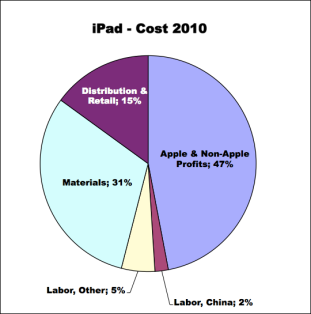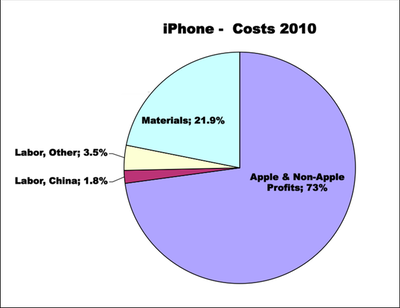Free marketeers and green-minded people tend to converge on a single belief — that electronic goods such as Apple iPhones and iPads are inherently unsustainable. Making such goods is only possible, the story goes, because of the unbearable mistreatment of workers who make those products, and the extraction of raw materials under environmentally destructive conditions. Treat workers fairly, and extract rare earths and such in ways that don’t degrade the ecology, and costs would explode — your iPad would carry the price tag of a small car.
 This argument is sometimes made by those who don’t want to see anything done about the horrible treatment of workers in places like Foxconn in China, where nets have been placed to catch workers driven to attempting suicide by jumping from building windows and roofs. Sometimes it is made by those who think this whole technological civilization thing is a mistake. In both cases it is wrong.
This argument is sometimes made by those who don’t want to see anything done about the horrible treatment of workers in places like Foxconn in China, where nets have been placed to catch workers driven to attempting suicide by jumping from building windows and roofs. Sometimes it is made by those who think this whole technological civilization thing is a mistake. In both cases it is wrong.
Here is the truth: The single greatest cost component of both the iPhone and the iPad is neither labor nor materials, but profits. (For a full accounting see this paper [PDF].) Labor costs in poor nations such as China and South Korea are such a small percentage of total costs that they could be doubled or tripled without buyers even noticing. Material costs are significant, but still could be doubled without the increase falling outside the fluctuations prices of electronic goods suffer during normal functioning of the global system.
In short, a global system that treats workers decently could provide iThings for about the same as they cost now. A global system that treats the environment decently would increase the cost of iThings slightly, but not by an amount unaffordable for anyone who can pay for them today.
In 2010, about 73 percent of the costs of the iPhone were profits for Apple and Apple partners and suppliers, as were 47 percent of the costs of the iPad. In terms of labor, only about 2 percent of total costs were Chinese labor, and the same or less for labor in Korea and Taiwan. The rest were material costs, and costs for labor in the U.S., the E.U., Japan, and other rich nations where labor conditions are not comparable to those in China, Korea, or Taiwan. Material costs are more substantial than labor, but still less than profits, about 22 percent for the iPhone and about 31 percent for the iPad.
 Doubling or tripling labor costs for iThings in poor nations would not even be noticeable compared to week-by-week variations in price. Doubling material costs to make those more sustainable (see * below for details) would be noticeable, though fluctuations of one-fifth to one-third are not unknown over the course of a year in the iThing market. And of course there is no reason, given the huge size of profit margins, that all of the increase should be absorbed by consumers.
Doubling or tripling labor costs for iThings in poor nations would not even be noticeable compared to week-by-week variations in price. Doubling material costs to make those more sustainable (see * below for details) would be noticeable, though fluctuations of one-fifth to one-third are not unknown over the course of a year in the iThing market. And of course there is no reason, given the huge size of profit margins, that all of the increase should be absorbed by consumers.
So it is not true that physical or cost barriers prevent sustainable electronics. All we need is a system where human needs are more important than profits. Yeah, nothing difficult about that one, is there? But why would we expect problems that stem from a system that prioritizes profits for the 1% to be solved through minor tweaking that does not affect the interests of that 1%?
* The reasons I think doubling (at most) the cost of materials would allow sustainability are:
A) Many of the environmental costs of materials used in electronics are energy and water. Use of both can be reduced through increased efficiency. Energy can be provided from renewable sources rather than fossil fuels. To the extent water use can’t be drastically reduced, it can be recycled through distillation and reverse osmosis if necessary, the energy for this provided from waste heat or renewable generation.
B) Other significant sources of environmental footprints for electronics are high-impact industrial gases. Again, these may be used more efficiently, and in some cases lower-impact gases substituted. To the extent their use remains necessary, they can be captured after use and recycled, or alternatively incinerated.
C) Another significant source of impacts is mining. Here again, various tricks can reduce the need for high environmental impact metals, such as rare earths. For example, catalysts, compounding rare earth with more common metals, nanomaterials, and sometimes just clever shaping can allow smaller quantities of rare or toxic materials to achieve the same effects larger quantities achieve today. More importantly, recycling and assigning end-of-life responsibility to manufacturers and importers can reduce the need for new mining. Also importantly, the mining itself can be done in a more responsible manner. All of these can help insure a long-term supply of rare earths to maintain the electronics industry until substitutes for them are developed. And it is worth remembering that much of the time poor and working class families in poor nations are the ones to lose their homes, their health and even their lives to the toxic effects of mining.
My 2004 online resource, Cooling It! No Hair Shirt Solutions to Global Warming, deals with the issue of the physical potential for sustainability with today’s technology (well, at this point ,with almost decade-old technology). It includes a discussion specifically about sustainability in electronics and appliances.
Editor’s Note: For additional discussion of the labeling of “profit” in this piece and in the pie charts above, see this post.



